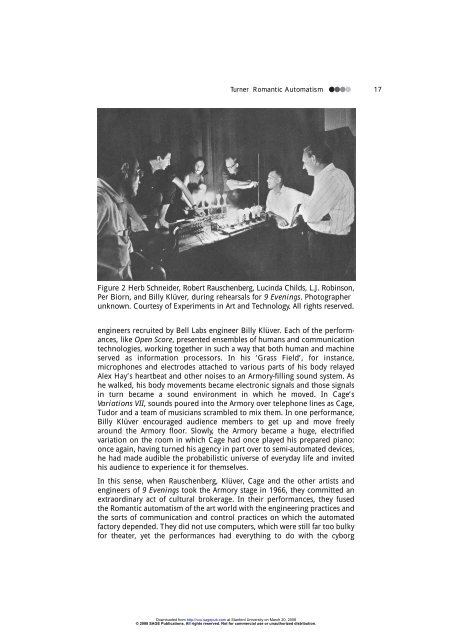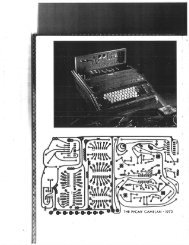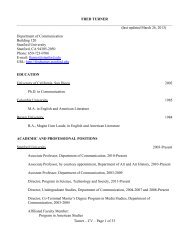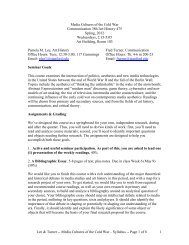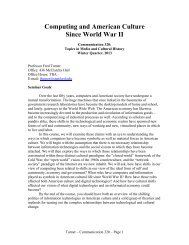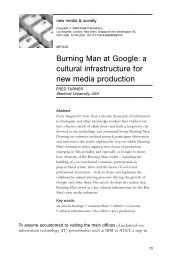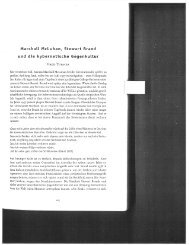Journal of Visual Culture - Fred Turner - Stanford University
Journal of Visual Culture - Fred Turner - Stanford University
Journal of Visual Culture - Fred Turner - Stanford University
You also want an ePaper? Increase the reach of your titles
YUMPU automatically turns print PDFs into web optimized ePapers that Google loves.
<strong>Turner</strong> Romantic Automatism 17<br />
Figure 2 Herb Schneider, Robert Rauschenberg, Lucinda Childs, L.J. Robinson,<br />
Per Biorn, and Billy Klüver, during rehearsals for 9 Evenings. Photographer<br />
unknown. Courtesy <strong>of</strong> Experiments in Art and Technology. All rights reserved.<br />
engineers recruited by Bell Labs engineer Billy Klüver. Each <strong>of</strong> the performances,<br />
like Open Score, presented ensembles <strong>of</strong> humans and communication<br />
technologies, working together in such a way that both human and machine<br />
served as information processors. In his ‘Grass Field’, for instance,<br />
microphones and electrodes attached to various parts <strong>of</strong> his body relayed<br />
Alex Hay’s heartbeat and other noises to an Armory-filling sound system. As<br />
he walked, his body movements became electronic signals and those signals<br />
in turn became a sound environment in which he moved. In Cage’s<br />
Variations VII, sounds poured into the Armory over telephone lines as Cage,<br />
Tudor and a team <strong>of</strong> musicians scrambled to mix them. In one performance,<br />
Billy Klüver encouraged audience members to get up and move freely<br />
around the Armory floor. Slowly, the Armory became a huge, electrified<br />
variation on the room in which Cage had once played his prepared piano:<br />
once again, having turned his agency in part over to semi-automated devices,<br />
he had made audible the probabilistic universe <strong>of</strong> everyday life and invited<br />
his audience to experience it for themselves.<br />
In this sense, when Rauschenberg, Klüver, Cage and the other artists and<br />
engineers <strong>of</strong> 9 Evenings took the Armory stage in 1966, they committed an<br />
extraordinary act <strong>of</strong> cultural brokerage. In their performances, they fused<br />
the Romantic automatism <strong>of</strong> the art world with the engineering practices and<br />
the sorts <strong>of</strong> communication and control practices on which the automated<br />
factory depended. They did not use computers, which were still far too bulky<br />
for theater, yet the performances had everything to do with the cyborg<br />
Downloaded from<br />
http://vcu.sagepub.com at <strong>Stanford</strong> <strong>University</strong> on March 20, 2008<br />
© 2008 SAGE Publications. All rights reserved. Not for commercial use or unauthorized distribution.


